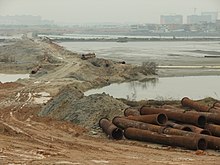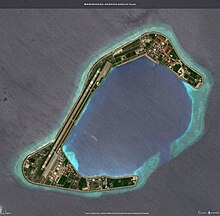
Since 1949, China has carried out extensive land reclamation projects. It is among the countries which have built the most artificial land; from 1949 to 1990s, the total area of land reclaimed from the sea of China was about 13,000 km.
Mainland China


A grand total of 150 km was planned to be reclaimed from the sea in 2009.
Guangdong
From June 2004 to the present, land reclamation is going on at Shantou. Project surface to reclaim is 146 km.
In 2020, Tencent announced its smart city-style urban development dubbed Net City, which will be built on reclaimed land in Shenzhen.
Jiangsu
Between 2009 and 2020, Jiangsu will reclaim 21 parcels of tidal areas along the southern Yellow Sea, yielding a total of 1,818 square km of new land.
Liaoning
Starting in March 2005, the Caofeidian Land Reclamation Project (曹妃甸围海造地工程) reclaimed a total of 310 km next to the island of Tangshan. The first stage of 12 km was finished on 28 March 2006. The plan is to make space for the new industrial base of Shougang.
Shanghai
Between 2003 and 2006, the Shanghai government spent 40 billion yuan on the Nanhui New City, formerly called Lingang New City Project (临港新城计划) of Shanghai, to reclaim 133.3 km of artificial land from the sea.
Zhejiang
Starting in 1975, the largest single land reclamation project in Zhejiang Province has been the Xuanmen Land Reclamation Project (漩门围垦工程) in Yuhuan County. It has three phases, of which phase II covered 53.3 km (February 1999 - April 2001), and phase III 45.3 km (March 2006 - 2010).
- Total land reclamation in the area of Taizhou City between 2004 and 2010, including the project mentioned above, will be 266.7 km.
Special Administrative Regions
Hong Kong
Main article: Land reclamation in Hong KongThe government of Hong Kong started reclaiming land from the surrounding sea as early as the 1840s. Formal reclamation starts at 1860s and its land reclamation is still proceeding. A notable achievement is Hong Kong International Airport, built in the 1990s on reclaimed land, absorbing the former islands Chek Lap Kok and Lam Chau.
The Shenzhen river (between Hong Kong and mainland China) has been channelised through land reclamation projects.
Macau
Further information: Geography of MacauMacau has been the site of land reclamation projects for several hundred years. As of 2023, more than half of Macau is composed to reclaimed land.
Macau's Cotai Strip was built upon a 5.2 square kilometer land reclamation site in the Seac Pai Bay of the Pearl River Estuary. The strip joins the formerly separate islands of Taipa and Coloane. The Cotai Strip is a gambling and shopping area which includes a dozen multibillion-dollar resorts, a private university campus, and the Macau garrison of the People's Liberation Army.

South China Sea
Further information: Nine-dash line and Territorial disputes in the South China SeaIn the 21st century, the PRC has upheld the 1947 claims of the Republic of China (modified by Zhou Enlai into a nine-dash line) over most of the South China Sea through a series of disputed mid-ocean land reclamation projects in the Spratly Islands known as the Great Wall of Sand. China was motivated to begin land reclamation projects in the Spratlys because it had relatively little land in the area.
The islands being expanded or created by the project are notionally administered as parts of Sansha in Hainan Province. As of December 2016, the projects in the Spratlys covered 3,200 acres (1,300 ha) of land protected by "'significant' weapons systems, including anti-aircraft and anti-missile systems".
See also
- Land rehabilitation
- Land improvement
- United States Bureau of Reclamation
- Society for Protection of the Harbor
- Territorial changes of the People's Republic of China
- Polder - low-lying land reclaimed from a lake or sea
- Soil salinity control - reclamation of saline land
- Watertable control - reclamation of waterlogged land
- Drainage system (agriculture) - drainage for land reclamation
References
- ChinaNews: 中國圍填海造地面積增長迅猛 (in traditional Chinese. "China's land reclamation from sea increases dramatically") Archived 2012-06-04 at archive.today "據統計,從一九四九年到上世紀末期,中國沿海地區圍填海造地面積達到一點二萬平方公里 ..."
- 2 trillion yuan to create artificial lands
- "广东省海洋功能区划获批 将围海造地146平方公里". Archived from the original on 2018-08-10. Retrieved 2009-05-15.
- Hu, Richard (2023). Reinventing the Chinese City. New York: Columbia University Press. ISBN 978-0-231-21101-7.
- 江苏沿海将开发近四成未围滩涂 规划建21个围区
- "海江工程船赴曹妃甸围海造地". Archived from the original on 2018-08-10. Retrieved 2009-05-15.
- 曹妃甸钢铁围海造地一期工程竣工
- 上海400亿填海造城被疑破坏环保
- 中国广播网:玉环漩门围垦开启“环漩门湾时代” Archived 2011-07-23 at the Wayback Machine
- 台州规划围海造地40万亩 Archived 2012-07-18 at archive.today
- Chatwin, Jonathan (2024). The Southern Tour: Deng Xiaoping and the Fight for China's Future. Bloomsbury Academic. ISBN 9781350435711.
- ^ Simpson, Tim (2023). Betting on Macau: Casino Capitalism and China's Consumer Revolution. Globalization and Community series. Minneapolis: University of Minnesota Press. ISBN 978-1-5179-0031-1.
- Wang, Frances Yaping (2024). The Art of State Persuasion: China's Strategic Use of Media in Interstate Disputes. Oxford University Press. ISBN 9780197757512.
- Phillips, Tom (2016-12-14). "Images show 'significant' Chinese weapons systems in South China Sea". The Guardian. ISSN 0261-3077. Retrieved 2016-12-15.
| Land reclamation | |
|---|---|